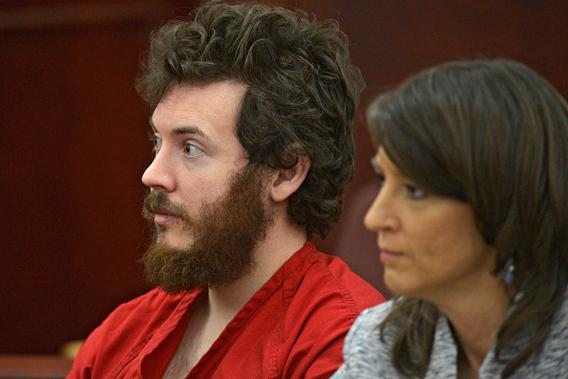What did police at the University of Colorado know about the homicidal intent of James Holmes, the Aurora, Colo., theater shooter? When did they know it? Did they share this information with police outside the university? If not, why not?
These are some of the questions provoked by court documents unsealed yesterday, a week after similar documents were released in the Tucson and Sandy Hook massacres. The Colorado records, related to early information and warrants, include some eyebrow-raising details. Images on Holmes’ phone show how carefully he scouted the theater weeks in advance, taking pictures of the door jamb. In addition to the propane tanks and other explosive items in his apartment, investigators found 50 containers of an unspecified liquid. Denver news station CALL7 notes that testimony at a January hearing “revealed many of the canisters contained layered combinations of improvised napalm, thermite and/or black powder.” But the number of containers, previously unreported, suggests he may have purchased ingredients in quantities that should have triggered alarms.
The clearest warning, however, came from Dr. Lynne Fenton, a psychiatrist at the university. At a hearing last August, Fenton confirmed that she had met with Holmes before the shooting. She testified that on June 11, a month before the tragedy, she contacted a university police officer, Lynn Whitten, about a patient. Fenton, asserting confidentiality, didn’t name the patient in court. She testified that “I communicated with Officer Whitten to gather more information about this case and to communicate my concerns.” According to a Denver Post account of the hearing, when Fenton “was asked in court whether she had ever contacted authorities for reasons required by the state law that mandates psychiatrists report specific threats of violence made by their patients, Fenton said she had not.”
The Post also reports that officials at the university “have denied that Holmes was banned from campus for making threats, saying instead that his key card was deactivated as part of a normal process when a student withdraws from school.”
But the newly released documents tell a different story. A July 23 police affidavit says that shortly after the shooting, Whitten told an Aurora police officer that Fenton had been much more explicit in their June conversations. According to the affidavit,
“Dr. Fenton advised that through her contact with James Holmes she was reporting, per her requirement, his danger to the public due to homicidal statements he had made. Additionally, Dr. Fenton was advising that she had been treating Holmes, and that Holmes had stopped seeing her and had begun threatening her via text messages.”
A July 24 affidavit says that on July 21, Whitten told investigators
“that Lynne Fenton had contacted Officer Whitten [regarding] James E. Holmes on June 12, 2012. Lynne Fenton described James E. Holmes as having Homicidal thoughts and also stated that James E. Holmes had threatened and harassed her via e-mail/text messages. Officer Whitten Advised Sergeant Wesner that she had deactivated James E. Holmes’ I.D. on June 12, 2012 due to that complaint.”
Threats. Harassment. Homicidal statements. Danger to the public. These were explicit warnings, conveyed to a police officer. Based on these warnings, the university police cut off Holmes’ access to campus facilities.
What did the university do to protect the broader public? We don’t know. The Post reports that “the documents don’t reveal what—if anything—campus authorities did to investigate Holmes” after barring him from their own facilities. CALL7 stands by its report that “neither Fenton nor the CU threat assessment team took action because Holmes had made it known he was going to leave the university.” CALL7 has also reported that according to its sources, university officials “never contacted Aurora police with Fenton’s concerns.”
As further evidence is unsealed in this case, we may learn more about what Fenton knew and disclosed. CALL7 says that according to testimony at the August hearing, “She wrote a four-page summary of her meeting with Holmes on June 11, but left blank a section designated for the treatment plan.” The search warrant records also show that at Holmes’ apartment, police found clonazepam, a psychiatric drug, as well as sedatives and sertraline (generic Zoloft).
What we know so far is that the public statements attributed to Fenton and university officials don’t match what’s in the police affidavits. And if the affidavits are correct, information about Holmes’ homicidal statements and danger to the public were deemed sufficient to trigger a warning to the university police, but not to the police who protect the rest of us. Why not?
